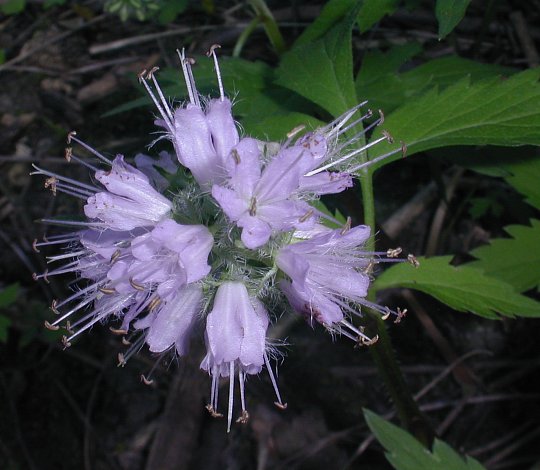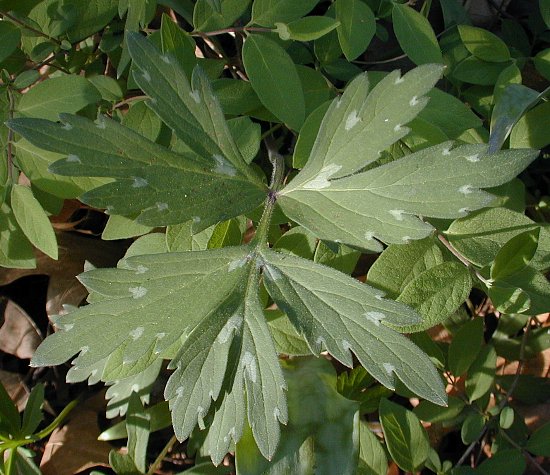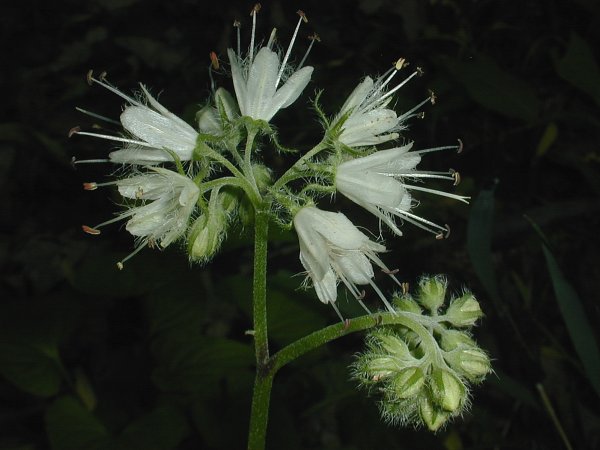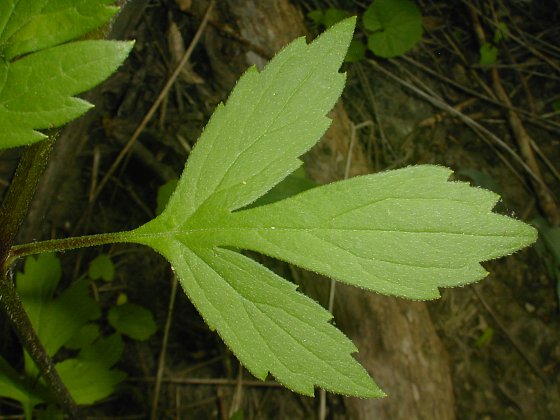Description: This herbaceous perennial plant is 1-2' tall, branching sparingly. The stems are green, reddish green, or reddish brown, and they are glabrous to slightly hairy. When they are present, these hairs are curved or appressed against their stems. The alternate leaves are up to 6" long and 4" across (excluding the petioles); they are pinnately divided into 3-5 leaflets or deep lobes, and their margins are coarsely toothed or shallowly cleft. The lobes of these leaves are relatively narrow and they have acute tips. The earliest leaves in spring have small patches of white that are scattered across their upper surfaces; these white patches don't develop in later leaves. The petioles are up to 2" long, light green to reddish brown, and glabrous to short-pubescent; they are flat or furrowed along their upper sides and convex below. Each upper stem terminates in 1 or 2 cymes of flowers. The flowering stalks (or peduncles) of these cymes are up to 4" long; they are terete and glabrous to short-pubescent.

The stalks terminate in dense cymes of flowers about 1-2" across; each cyme contains about 8-20 flowers. Each flower is about 8-12 mm. long, consisting of a corolla with 5 lobes, a hairy green calyx with 5 linear teeth, 5 stamens, and a slender white style that is divided at its tip. The corolla is white, pink, or light lavender; its oblong lobes spread apart only slightly when the flower is fully open. The stamens are strongly exerted from the corolla and quite conspicuous; they have hairy white filaments and brownish anthers. The pedicels of the flowers are up to 12 mm. (½") in length; they are terete and glabrous to short-pubescent. The blooming period occurs during late spring to early summer, lasting about 3-4 weeks; some plants may bloom a little earlier or later than this. Each flower is replaced by a seed capsule that splits open to release its seeds. The root system consists of a tuft of fibrous roots and rhizomes. Occasionally, this plant forms colonies.

Cultivation:
The
preference is partial sun to light shade, moist to dry-mesic
conditions, and a rich loamy soil with decaying leaves. This plant can
be cultivated in gardens where there is some shade from deciduous trees.
Range & Habitat:
The native Virginia Waterleaf is occasional to locally common in
central and northern Illinois, while in southern Illinois it is
uncommon or absent (see Distribution
Map).
Habitats include deciduous woodlands, savannas, areas along woodland
paths, wooded slopes along rivers, bluffs, edges of clearings in
wooded areas, and powerline clearances in wooded areas. This wildflower
benefits from occasional disturbance if it removes excessive woody
vegetation, and populations of this species decline in response to
invasion from Garlic Mustard (Alliaria
petiolata).

Faunal
Associations:
The nectar and pollen of the flowers attract bumblebees, long-horned
bees (Synhalonia spp.),
cuckoo bees (Nomada spp.),
mason bees (Osmia spp.),
Halictid bees (Lasioglossum
spp., Augochlorella
spp., etc.), Andrenid bees (Andrena spp.), and
bee flies (Bombyliidae). An Andrenid bee, Andrena geranii, is
a specialist pollinator of Hydrophyllum
spp. Syrphid flies sometimes feed on the pollen of the
flowers, but they are less effective at cross-pollination. The
foliage is browsed by White-tailed Deer occasionally.
Photographic Location: Busey
Woods in Urbana, Illinois.

Comments: This is probably the most common Hydrophyllum sp. in Illinois. Virginia Waterleaf has attractive flowers and foliage; it blooms a little later than most spring-blooming wildflowers in woodlands. The following characteristics distinguish this species from other Hydrophyllum spp. that occur in the state: 1) There are no curved appendages between the teeth of the calyx, 2) the stems are hairless, or they have lines of hairs that are curved or appressed against the stem, 3) the leaves are pinnately lobed and they are usually a little longer than wide, 4) the lobes of the corolla spread apart only a little, 5) the stamens and styles are longer than their corollas, and 6) the lobes of the leaves have acute tips. Other Hydrophyllum spp. have little appendages between the teeth of their calyxes, or they have stems with abundant spreading hairs, or they have palmately lobed leaves that are as wide as they are long, or the lobes of their corollas spread widely apart, or their stamens and styles are no longer than their corollas, or the lobes of their leaves have blunt tips. While this set of distinctions may sound complicated, it is usually easy to identify Virginia Waterleaf in the field.